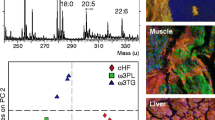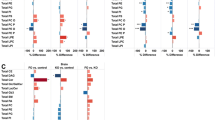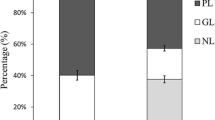Abstract
It is well recognized that a high dietary intake of long-chain polyunsaturated fatty acids (LC-PUFA) has profound benefits on health and prevention of chronic diseases. In particular, in recent years there has been a dramatic surge of interest in the health effects of n-3 LC-PUFA derived from fish, eicosapentaenoic (EPA) and docosahexaenoic (DHA) acids. Notwithstanding, the metabolic fate and the effects of these fatty acids once inside the cell has seldom been comprehensively investigated. Using cultured neonatal rat cardiomyocytes as model system we have investigated for the first time, by means of high-resolution magic-angle spinning nuclear magnetic resonance (HR-MAS NMR) spectroscopy in combination with gas chromatography (GC), the modification occurring in the cell lipid environment after EPA and DHA supplementation. The most important difference between control and n-3 LC-PUFA-supplemented cardiomyocytes highlighted by HR-MAS NMR spectroscopy is the increase of signals from mobile lipids, identified as triacylglycerols (TAG). The observed increase of mobile TAG is a metabolic response to n-3 LC-PUFA supplementation, which leads to an increased lipid storage. The sequestration of mobile lipids in lipid bodies provides a deposit of stored energy that can be accessed in a regulated fashion according to metabolic need. Interestingly, while n-3 LC-PUFA supplementation to neonatal rat cardiomyocytes causes a huge variation in the cell lipid environment, it does not induce detectable modifications in water-soluble metabolites, suggesting negligible interference with normal metabolic processes.







Similar content being viewed by others
Abbreviations
- 1D:
-
Monodimensional
- 2D:
-
Bidimensional
- α-CH:
-
α-CH of aminoacids
- Ac:
-
Acetate
- Ala:
-
Alanine
- ARA:
-
Arachidonic acid
- C:
-
Cholesterol
- CE:
-
Cholesteryl esters
- Cho:
-
Choline
- ChoCC:
-
Choline-containing compounds
- COSY:
-
Correlation spectroscopy
- CPMG:
-
Carr–Purcell–Meiboom–Gill
- Cr:
-
Creatine
- DHA:
-
Docosahexaenoic acid
- DPAn-3:
-
Docosapentaenoic acid
- EPA:
-
Eicosapentaenoic acid
- Etn:
-
Ethanolamine
- FA:
-
Fatty acid(s)
- FCS:
-
Fetal calf serum
- FFA:
-
Unesterified fatty acids
- GC:
-
Gas chromatography
- Gln:
-
Glutamine
- Glu:
-
Glutamate
- Gly:
-
Glycine
- GPC:
-
Glycerophosphocholine
- HR-MAS:
-
High-resolution magic-angle spinning
- HS:
-
Horse serum
- Lac:
-
Lactate
- LB:
-
Lipid body(ies)
- LC-PUFA:
-
Long chain polyunsaturated fatty acid(s)
- Lys:
-
Lysine
- MUFA:
-
Monounsaturated fatty acid(s)
- Myo:
-
Myo-inositol
- NMR:
-
Nuclear magnetic resonance
- PCho:
-
Phosphocholine
- PEtn:
-
Phosphoethanolamine
- PL:
-
Phospholipid(s)
- PtdCho:
-
Phosphatidylcholine
- PUFA:
-
Polyunsaturated fatty acid(s)
- Scy:
-
Scyllo-inositol
- TAG:
-
Triacylglycerol(s)
- Tau:
-
Taurine
- TLC:
-
Thin-layer chromatography
- TOCSY:
-
Total correlation spectroscopy
- UDP:
-
Uridine diphosphate
References
Siddiqui RA, Shaikh SR, Sech LA, Yount HR, Stillwell W, Zaloga GP (2004) Omega 3-fatty acids: health benefits and cellular mechanisms of action. Mini Rev Med Chem 4:859–871
Jump DB (2002) Dietary polyunsaturated fatty acids and regulation of gene transcription. Curr Opin Lipidol 13:155–164. doi:10.1097/00041433-200204000-00007
Marik PE, Varon J (2009) Omega-3 dietary supplements and the risk of cardiovascular events: a systematic review. Clin Cardiol 32:365–372. doi:10.1002/clc.20604
von Schacky C (2003) The role of omega-3 fatty acids in cardiovascular disease. Curr Atheroscler Rep 5:139–145. doi:10.1007/s11883-003-0086-y
Engler MM, Engler MB (2006) Omega-3 fatty acids: role in cardiovascular health and disease. J Cardiovasc Nurs 21:17–24
Christie WW, Brechany EY, Shukla VK (1989) Analysis of seed oils containing cyclopentenyl fatty acids by combined chromatographic procedures. Lipids 24:116–120. doi:10.1007/BF02535247
Guo W, Hamilton JA (1996) 13C MAS NMR studies of crystalline cholesterol and lipid mixtures modeling atherosclerotic plaques. Biophys J 71:2857–2868. doi:10.1016/S0006-3495(96)79482-1
Forbes J, Husted C, Oldfield E (1988) High-field, high-resolution proton “magic-angle” sample-spinning nuclear magnetic resonance spectroscopic studies of gel and liquid crystalline lipid bilayers and the effects of cholesterol. J Am Oil Chem Soc 110:1059–1065. doi:10.1021/ja00212a010
Wishart DS (2005) Metabolomics: the principles and potential applications to transplantation. Am J Transplant 5:2814–2820. doi:10.1111/j.1600-6143.2005.01119.x
Nicholson JK, Lindon JC (2008) Systems biology: metabonomics. Nature 455:1054–1056. doi:10.1038/4551054a
Duarte IF, Marques J, Ladeirinha AF, Rocha C, Lamego I, Calheiros R, Silva TM, Marques MP, Melo JB, Carreira IM, Gil AM (2009) Analytical approaches toward successful human cell metabolome studies by NMR spectroscopy. Anal Chem 81:5023–5032. doi:10.1021/ac900545q
Yagev S, Heller M, Pinson A (1984) Changes in cytoplasmic and lysosomal enzyme activities in cultured rat heart cells: the relationship to cell differentiation and cell population in culture. In Vitro 20:893–898. doi:10.1007/BF02619662
Folch J, Lees M, Sloane Stanley GH (1957) A simple method for the isolation and purification of total lipids from animal tissues. J Biol Chem 226:497–509
Stoffel W, Chu F, Ahrens EH (1959) Analysis of long-chain fatty acids by gas–liquid chromatography. Micromethod for preparation of methyl esters. Anal Chem 31:307–308. doi:10.1021/ac60146a047
Bordoni A, Angeloni C, Leoncini E, Danesi F, Maranesi M, Biagi PL, Hrelia S (2005) Hypoxia/reoxygenation alters essential fatty acids metabolism in cultured rat cardiomyocytes: protection by antioxidants. Nutr Metab Cardiovasc Dis 15:166–173. doi:10.1016/j.numecd.2004.04.003
Schenetti L, Mucci A, Parenti F, Cagnoli R, Righi V, Tosi MR, Tugnoli V (2006) HR-MAS NMR spectroscopy in the characterization of human tissues: application to healthy gastric mucosa. Concepts Magn Reson Part A Bridg Educ Res 28A:430–443. doi:10.1002/cmr.a.20068
Price WS, Hayamizu K, Ide H, Arata Y (1999) Strategies for diagnosing and alleviating artifactual attenuation associated with large gradient pulses in PGSE NMR diffusion measurements. J Magn Reson 139:205–212. doi:10.1006/jmre.1999.1789
Meiboom S, Gill D (1958) Modified spin-echo method for measuring nuclear relaxation times. Rev Sci Instrum 29:688–691. doi:10.1063/1.1716296
Wu DH, Chen AD, Johnson CS (1995) An improved diffusion-ordered spectroscopy experiment incorporating bipolar-gradient pulses. J Magn Reson A 115:260–264. doi:10.1006/jmra.1995.1176
Jeener J (1971) Pulse pair techniques in high resolution NMR. Ampère International Summer School, Basko Polje
Aue WP, Bartholdi E, Ernst RR (1976) Two-dimensional spectroscopy. Application to nuclear magnetic resonance. J Chem Phys 64:2229–2246. doi:10.1063/1.432450
Bax A, Davis DG (1985) MLEV-17-based two-dimensional homonuclear magnetization transfer spectroscopy. J Magn Reson 65:355–360. doi 10.1016/0022-2364(85)90018-6
Braunschweiler L, Ernst RR (1983) Coherence transfer by isotropic mixing: Application to proton correlation spectroscopy. J Magn Reson 53:521–528. doi 10.1016/0022-2364(83)90226-3
Tugnoli V, Mucci A, Schenetti L, Righi V, Calabrese C, Fabbri A, Di Febo G, Tosi MR (2006) Ex vivo HR-MAS Magnetic Resonance Spectroscopy of human gastric adenocarcinomas: a comparison with healthy gastric mucosa. Oncol Rep 16:543–553
Subramanian A, Shankar Joshi B, Roy AD, Roy R, Gupta V, Dang RS (2008) NMR spectroscopic identification of cholesterol esters, plasmalogen and phenolic glycolipids as fingerprint markers of human intracranial tuberculomas. NMR Biomed 21:272–288. doi:10.1002/nbm.1191
Tugnoli V, Tosi MR, Tinti A, Trinchero A, Bottura G, Fini G (2001) Characterization of lipids from human brain tissues by multinuclear magnetic resonance spectroscopy. Biopolymers 62:297–306. doi:10.1002/bip.10005
Hakumaki JM, Kauppinen RA (2000) 1H NMR visible lipids in the life and death of cells. Trends Biochem Sci 25:357–362. doi:10.1016/S0968-0004(00)01614-5
Fan TWM (1996) Metabolite profiling by one- and two-dimensional NMR analysis of complex mixtures. Prog Nucl Magn Reson Spectrosc 28:161–219. doi:10.1016/0079-6565(95)01017-3
Tugnoli V, Schenetti L, Mucci A, Parenti F, Cagnoli R, Righi V, Trinchero A, Nocetti L, Toraci C, Mavilla L, Trentini G, Zunarelli E, Tosi MR (2006) Ex vivo HR-MAS MRS of human meningiomas: a comparison with in vivo 1H MR spectra. Int J Mol Med 18:859–869
Leonard AE, Pereira SL, Sprecher H, Huang YS (2004) Elongation of long-chain fatty acids. Prog Lipid Res 43:36–54. doi:10.1016/S0163-7827(03)00040-7
Bangham AD (1975) Cell membranes: biochemistry, cell biology and pathology. In: Weissmann G, Claiborne R (eds) Models of cell membranes, hospital practice. HP Publishing, New York, pp 24–34
Williams E, Hamilton JA, Jain MK, Allerhand A, Cordes EH, Ochs S (1973) Natural abundance carbon-13 nuclear magnetic resonance spectra of the canine sciatic nerve. Science 181:869–871. doi:10.1126/science.181.4102.869
Montez B, Oldfield E, Urbina JA, Pekerar S, Husted C, Patterson J (1993) Editing 13C-NMR spectra of membranes. Biochim Biophys Acta 1152:314–318. doi:10.1016/0005-2736(93)90263-Y
Peng S, Guo W, Morrisett JD, Johnstone MT, Hamilton JA (2000) Quantification of cholesteryl esters in human and rabbit atherosclerotic plaques by magic-angle spinning (13)C-NMR. Arterioscler Thromb Vasc Biol 20:2682–2688
Ruberg FL, Viereck J, Phinikaridou A, Qiao Y, Loscalzo J, Hamilton JA (2006) Identification of cholesteryl esters in human carotid atherosclerosis by ex vivo image-guided proton MRS. J Lipid Res 47:310–317. doi:10.1194/jlr.M500431-JLR200
Bruno MJ, Koeppe RE II, Andersen OS (2007) Docosahexaenoic acid alters bilayer elastic properties. Proc Natl Acad Sci USA 104:9638–9643. doi:10.1073/pnas.0701015104
Schmitz G, Ecker J (2008) The opposing effects of n-3 and n-6 fatty acids. Prog Lipid Res 47:147–155. doi:10.1016/j.plipres.2007.12.004
Catalá A (2009) Lipid peroxidation of membrane phospholipids generates hydroxy-alkenals and oxidized phospholipids active in physiological and/or pathological conditions. Chem Phys Lipids 157:1–11. doi:10.1016/j.chemphyslip.2008.09.004
Siener R, Alteheld B, Terjung B, Junghans B, Bitterlich N, Stehle P, Metzner C (2010) Change in the fatty acid pattern of erythrocyte membrane phospholipids after oral supplementation of specific fatty acids in patients with gastrointestinal diseases. Eur J Clin Nutr 64:410–418. doi:10.1038/ejcn.2009.151
Stillwell W, Wassall SR (2003) Docosahexaenoic acid: membrane properties of a unique fatty acid. Chem Phys Lipids 126:1–27. doi:10.1016/S0009-3084(03)00101-4
Bate C, Marshall V, Colombo L, Diomede L, Salmona M, Williams A (2008) Docosahexaenoic and eicosapentaenoic acids increase neuronal death in response to HuPrP82–146 and Abeta 1–42. Neuropharmacology 54:934–943. doi:10.1016/j.neuropharm.2008.02.003
Mountford CE, Wright LC (1988) Organization of lipids in the plasma membranes of malignant and stimulated cells: a new model. Trends Biochem Sci 13:172–177. doi:10.1016/0968-0004(88)90145-4
Mackinnon WB, May GL, Mountford CE (1992) Esterified cholesterol and triglyceride are present in plasma membranes of Chinese hamster ovary cells. Eur J Biochem 205:827–839. doi:10.1111/j.1432-1033.1992.tb16847.x
Barba I, Cabañas ME, Arús C (1999) The relationship between nuclear magnetic resonance-visible lipids, lipid droplets, and cell proliferation in cultured C6 cells. Cancer Res 59:1861–1868
Iorio E, Di Vito M, Spadaro F, Ramoni C, Lococo E, Carnevale R, Lenti L, Strom R, Podo F (2003) Triacsin C inhibits the formation of 1H NMR-visible mobile lipids and lipid bodies in HuT 78 apoptotic cells. Biochim Biophys Acta 1634:1–14. doi:10.1016/j.bbalip.2003.07.001
Ferretti A, Knijn A, Iorio E, Pulciani S, Giambenedetti M, Molinari A, Meschini S, Stringaro A, Calcabrini A, Freitas I, Strom R, Arancia G, Podo F (1999) Biophysical and structural characterization of 1H-NMR-detectable mobile lipid domains in NIH-3T3 fibroblasts. Biochim Biophys Acta 1438:329–348. doi:10.1016/S1388-1981(99)00071-2
Paul A, Chan L, Bickel PE (2008) The PAT family of lipid droplet proteins in heart and vascular cells. Curr Hypertens Rep 10:461–466. doi:10.1007/s11906-008-0086-y
Finstad HS, Drevon CA, Kulseth MA, Synstad AV, Knudsen E, Kolset SO (1998) Cell proliferation, apoptosis and accumulation of lipid droplets in U937–1 cells incubated with eicosapentaenoic acid. Biochem J 336(Pt 2):451–459
Quintero M, Cabañas ME, Arús C (2007) A possible cellular explanation for the NMR-visible mobile lipid (ML) changes in cultured C6 glioma cells with growth. Biochim Biophys Acta 1771:31–44. doi:10.1016/j.bbalip.2006.10.003
Luciani AM, Grande S, Palma A, Rosi A, Giovannini C, Sapora O, Viti V, Guidoni L (2009) Characterization of 1H NMR detectable mobile lipids in cells from human adenocarcinomas. FEBS J 276:1333–1346. doi:10.1111/j.1742-4658.2009.06869.x
Martin S, Parton RG (2006) Lipid droplets: a unified view of a dynamic organelle. Nat Rev Mol Cell Biol 7:373–378. doi:10.1038/nrm1912
Gambert S, Helies-Toussaint C, Grynberg A (2005) Regulation of intermediary metabolism in rat cardiac myocyte by extracellular glycerol. Biochim Biophys Acta 1736:152–162. doi:10.1016/j.bbalip.2005.08.004
Bordoni A, Astolfi A, Morandi L, Pession A, Danesi F, Di Nunzio M, Franzoni M, Biagi P (2007) N-3 PUFAs modulate global gene expression profile in cultured rat cardiomyocytes. Implications in cardiac hypertrophy and heart failure. FEBS Lett 581:923–929. doi:10.1016/j.febslet.2007.01.070
Guo W, Kurze V, Huber T, Afdhal NH, Beyer K, Hamilton JA (2002) A solid-state NMR study of phospholipid-cholesterol interactions: sphingomyelin-cholesterol binary systems. Biophys J 83:1465–1478. doi:10.1016/S0006-3495(02)73917-9
Husted C, Montez B, Le C, Moscarello MA, Oldfield E (1993) Carbon-13 “magic-angle” sample-spinning nuclear magnetic resonance studies of human myelin, and model membrane systems. Magn Reson Med 29:168–178. doi:10.1002/mrm.1910290204
Finstad HS, Dyrendal H, Myhrstad MC, Heimli H, Drevon CA (2000) Uptake and activation of eicosapentaenoic acid are related to accumulation of triacylglycerol in Ramos cells dying from apoptosis. J Lipid Res 41:554–563
Acknowledgments
This study was supported by a grant of MIUR ex 60% to VT, SB and AB.
Conflict of interest
The authors declare that there are no conflicts of interest.
Author information
Authors and Affiliations
Corresponding author
About this article
Cite this article
Righi, V., Di Nunzio, M., Danesi, F. et al. EPA or DHA Supplementation Increases Triacylglycerol, but not Phospholipid, Levels in Isolated Rat Cardiomyocytes. Lipids 46, 627–636 (2011). https://doi.org/10.1007/s11745-011-3562-0
Received:
Accepted:
Published:
Issue Date:
DOI: https://doi.org/10.1007/s11745-011-3562-0




